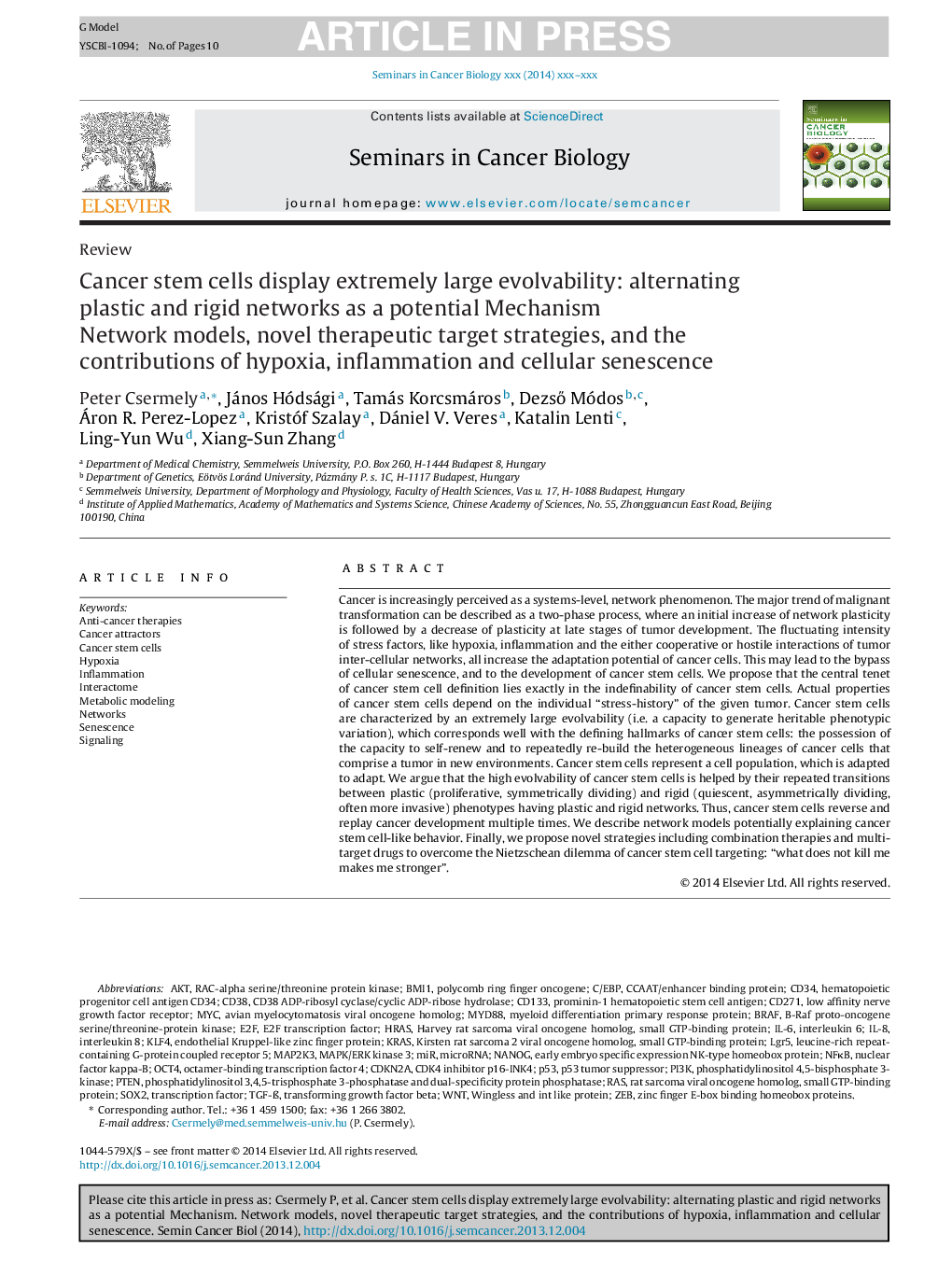| کد مقاله | کد نشریه | سال انتشار | مقاله انگلیسی | نسخه تمام متن |
|---|---|---|---|---|
| 8362274 | 1542537 | 2015 | 10 صفحه PDF | دانلود رایگان |
عنوان انگلیسی مقاله ISI
Cancer stem cells display extremely large evolvability: alternating plastic and rigid networks as a potential Mechanism
ترجمه فارسی عنوان
سلول های بنیادی سرطانی تکامل پذیری بسیار بالایی را نشان می دهند: شبکه های پلاستیکی و سفت و سخت متناوب به عنوان مکانیسم بالقوه
دانلود مقاله + سفارش ترجمه
دانلود مقاله ISI انگلیسی
رایگان برای ایرانیان
کلمات کلیدی
MIRCD34BRAFCD38CDKN2AHRASIL-8TGF-ßSox2Oct4CD133WntNANOGRASZEBE2F transcription factorE2FKLF4leucine-rich repeat-containing G-protein coupled receptor 5KRASCD271PI3KMYD88MYCAnti-cancer therapiesLGR5p53IL-6Bmi1 - BMI1C/EBP - C / EBPNFκB - NFKBAkt - آکتinflammation - التهاب( توروم) interleukin 6 - اینترلوکین 6Interleukin 8 - اینترلوکین 8Transforming Growth Factor Beta - تبدیل بتا فاکتور رشدinteractome - تعاملp53 tumor suppressor - سرکوب کننده تومور p53Cancer stem cells - سلولهای بنیادی سرطانیSignaling - سیگنالینگNetworks - شبکه هاTranscription factor - عامل رونویسیoctamer-binding transcription factor 4 - فاکتور رونویسی اتصال دهنده octamer 4nuclear factor kappa-B - فاکتور هسته ای کاپا-BMetabolic modeling - مدلسازی متابولیکMicroRNA - میکرو RNA Hypoxia - هیپوکسیCCAAT/enhancer binding protein - پروتئین اتصال CCAAT / enhancerSenescence - پیریPten - ژن PTENlow affinity nerve growth factor receptor - گیرنده فاکتور رشد عصبی کم
ترجمه چکیده
سرطان به صورت فزاینده ای در سطح سیستم، پدیده شبکه درک می شود. روند اصلی تحول بدخیم را می توان به عنوان یک فرآیند دو مرحلۀ توصیف کرد، که در آن افزایش ابتدای پلاستیسیته شبکه با کاهش پلاستیسیته در مراحل دیر توسعه تومور همراه است. شدت نوسانات عوامل استرس مانند هیپوکسی، التهاب و یا تعاملات متقابل یا خصومت آمیز شبکه های بین سلولی تومور، باعث افزایش پتانسیل انطباق سلول های سرطانی می شود. این ممکن است منجر به دور زدن پیری سلولی و رشد سلول های بنیادی سرطانی شود. ما پیشنهاد می کنیم که اصل مرکزی تعریف سلول های بنیادی سرطان دقیقا در عدم تعریف سلول های بنیادی سرطانی باشد. خواص واقعی سلول های بنیادی سرطانی به انسانی استرس سابقه بستگی دارد. از تومور داده شده. سلول های بنیادی سرطانی با تکامل پذیری بسیار بالایی (یعنی ظرفیت تولید تغییرات فنوتیپی سرنوشت ساز) مشخص می شوند، که با مشخصه های مشخصی از سلول های بنیادی سرطانی همخوانی دارد: داشتن ظرفیت خود تجدید و بارگذاری مجدد ناهمگونی سلول های سرطانی که تومور را در محیط های جدید تشکیل می دهند. سلول های بنیادی سرطانی جمعیت سلولی را نشان می دهند که برای انطباق سازگار است. ما استدلال می کنیم که تکامل پذیری بالا سلول های بنیادی سرطانی از طریق گذار مکرر آنها بین پلاستیک (پرولیفراتیو، تقسیم متقارن) و سفت (تقسیم، تقسیم نامتقارن، اغلب تهاجمی) فنوتیپ هایی با شبکه های پلاستیکی و سفت و سخت است. بنابراین، سلول های بنیادی سرطانی به عقب می روند و چندین بار سرطان را دوباره پخش می کنند. ما مدل های شبکه ای را توضیح می دهیم که به طور بالقوه رفتار سلول های بنیادی سرطانی را توضیح می دهد. سرانجام، ما استراتژی های جدیدی را پیشنهاد می کنیم که ترکیبی از درمان ها و داروهای چند هدف برای غلبه بر نگرش نیچه برای هدف قرار دادن سلول های بنیادی سرطانی است: چه چیزی من را نمی کشد؟
موضوعات مرتبط
علوم زیستی و بیوفناوری
بیوشیمی، ژنتیک و زیست شناسی مولکولی
زیست شیمی
چکیده انگلیسی
Cancer is increasingly perceived as a systems-level, network phenomenon. The major trend of malignant transformation can be described as a two-phase process, where an initial increase of network plasticity is followed by a decrease of plasticity at late stages of tumor development. The fluctuating intensity of stress factors, like hypoxia, inflammation and the either cooperative or hostile interactions of tumor inter-cellular networks, all increase the adaptation potential of cancer cells. This may lead to the bypass of cellular senescence, and to the development of cancer stem cells. We propose that the central tenet of cancer stem cell definition lies exactly in the indefinability of cancer stem cells. Actual properties of cancer stem cells depend on the individual “stress-history” of the given tumor. Cancer stem cells are characterized by an extremely large evolvability (i.e. a capacity to generate heritable phenotypic variation), which corresponds well with the defining hallmarks of cancer stem cells: the possession of the capacity to self-renew and to repeatedly re-build the heterogeneous lineages of cancer cells that comprise a tumor in new environments. Cancer stem cells represent a cell population, which is adapted to adapt. We argue that the high evolvability of cancer stem cells is helped by their repeated transitions between plastic (proliferative, symmetrically dividing) and rigid (quiescent, asymmetrically dividing, often more invasive) phenotypes having plastic and rigid networks. Thus, cancer stem cells reverse and replay cancer development multiple times. We describe network models potentially explaining cancer stem cell-like behavior. Finally, we propose novel strategies including combination therapies and multi-target drugs to overcome the Nietzschean dilemma of cancer stem cell targeting: “what does not kill me makes me stronger”.
ناشر
Database: Elsevier - ScienceDirect (ساینس دایرکت)
Journal: Seminars in Cancer Biology - Volume 30, February 2015, Pages 42-51
Journal: Seminars in Cancer Biology - Volume 30, February 2015, Pages 42-51
نویسندگان
Peter Csermely, János Hódsági, Tamás Korcsmáros, DezsÅ Módos, Áron R. Perez-Lopez, Kristóf Szalay, Dániel V. Veres, Katalin Lenti, Ling-Yun Wu, Xiang-Sun Zhang,
